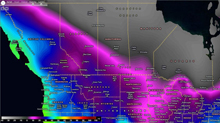
Daily high on gradient map.
New forecasting technology on WeatherFarm™ will greatly improve weather predictions, reducing error in short-term forecasts by as much as 50 per cent. This will assist in everything from spring flooding forecasts to storm watches to monitoring wind conditions – all of high importance in agriculture. WeatherFarm is an online weather information centre designed exclusively for Prairie farmers by the Canadian Wheat Board (CWB) and WeatherBug®, incorporating data from its own network of 800 weather stations and 200 government sites. It is the first in Canada to incorporate automated “nudging” techniques, using live local weather information from its Prairie-wide network, to fine-tune weather predictions.
“With all the potential for flooding this spring, everyone will be watching the weather very closely,” said CWB weather network manager and agro-meteorologist Guy Ash. “Farming is all about the weather, so producers need their weather information to be as accurate and localized as possible. This is really a case of Prairie farmers leading the way in creating a weather network that can benefit all Canadians.”
The new system integrates a weather-modelling system used by the U.S. National Weather Service and the U.S. military with “nudging” techniques that fine-tune computer forecasts against actual surface weather conditions to adjust predictions for better accuracy. It is commonly accepted in the scientific community that these adjustments improve accuracy by as much as 50 per cent in forecasts of up to 12 hours.
The new forecasting model is powered by WeatherBug, a brand of Earth Networks, integrating weather information from more than 8,000 weather stations around the world, including its stations in Canada. Forecasts predict hourly conditions for temperature, wind, relative humidity, a heat and wind-chill index, dew point, sky cover and chance of precipitation. A new set of forecasts for each local station is generated every six hours.
The enhanced forecasting, using a Weather Research and Forecasting (WRF) model, is made possible by the density of the network of 800 monitoring stations located on farms and at grain elevators across the Prairies. Launched in 2007 by the CWB, WeatherBug and grain-industry partners, it has now grown to become the largest private weather network in Canada. Earth Networks is working to expand the network across the entire country, extending the benefits of its improved weather forecasting and monitoring applications to all Canadians.
Another valuable enhancement is the introduction of radar imaging to generate birds-eye map views of weather systems (static or animated) that can move and zoom to within one kilometer above a particular farm, allowing producers to visually pinpoint immediate weather threats. The map views can also distinguish between rain, freezing rain and snow. “The radar imagery shows the exact locations, amounts and types of precipitation that are falling,” Ash said. “When producers zoom in, they can see exactly how close it is to their farm.”
The online WeatherFarm centre – which now serves over 10,000 users – has also been upgraded with colourful “visual gradient” temperature and precipitation maps, updated every 10 minutes, showing weather systems as they move across Canada, North America and the world. A handy scroll-down window enables users to choose between 10 different weather parameters for their maps.
The new features add to WeatherFarm’s unique agricultural maps and models, used by farmers to manage emergence of pests like fusarium head blight and wheat midge, monitor crop growth stages and assess freeze severity. An enhanced set of models for various crops will be rolled out this spring.
WeatherFarm is free to use, simply by registering at weatherfarm.com. Guests may also browse the site without registering. Producers who want to join the network can purchase a linked-in weather station through the CWB by contacting alison_sass@cwb.ca . A high-speed Internet connection is required. Far surpassing original expectations for its growth, WeatherFarm is on track to revolutionize the way weather information is gathered, shared and used in Canada – by farmers, media, business, government and the public – enhancing services from Environment Canada.



